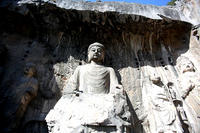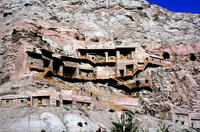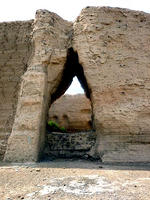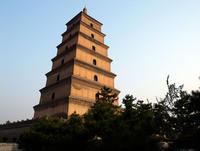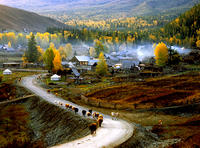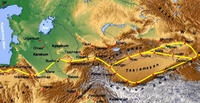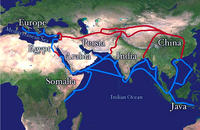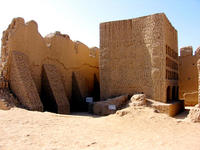You are in: Asia -> China -> Silk Roads: the Rout... , and traditional search or Image Gallery will yield results of this site only
Silk Roads: the Routes Network of Chang'an-Tianshan Corridor
| Site number: | 1442 |
|
| Type of site: | Cultural | |
| Date: | 2 BC - 1 AD | |
| Date of Inscription: | 2014 | |
| Location: | Asia, China, Kazakhstan , Kyrgyzstan, Chang’an/Luoyang | |
Up to 75 images are shown here. Click on each for more details or on Image Gallery for more images.
| Description: | This property is a 5,000 km section of the extensive Silk Roads network, stretching from Chang’an/Luoyang, the central capital of China in the Han and Tang dynasties, to the Zhetysu region of Central Asia. It took shape between the 2nd century BC and 1st century AD and remained in use until the 16th century, linking multiple civilizations and facilitating far-reaching exchanges of activities in trade, religious beliefs, scientific knowledge, technological innovation, cultural practices and the arts. The thirty-three components included in the routes network include capital cities and palace complexes of various empires and Khan kingdoms, trading settlements, Buddhist cave temples, ancient paths, posthouses, passes, beacon towers, sections of The Great Wall, fortifications, tombs and religious buildings. --From the description at WHC Site, where additional information is available. | |
| The Silk Road's Chang'an-Tianshan Corridor, which was approved by the World Heritage Committee in June 2014 as Site No. 1442, consists of 33 newly designated sites in China, Kazakhstan and Kyrgyzstan. The sites include capital cities and palace complexes of various empires and kingdoms, trading settlements, Buddhist cave temples, ancient paths, posthouses, mountain passes, beacon towers, sections of the Great Wall, fortifications, tombs and religious buildings. Collectively, the 33 sites cover an area of 42,668.16 ha (164.7 sq mi) and have buffer zone 189,963.13 ha (733.5 sq mi). The sites are categorized into four regions along the Silk Road by ICOMOs, which assessed eligibility for the World Heritage inscription: 1. Central China - ancient imperial capitals in the Central and Guanzhong Plains of China. 2. Hexi Corridor in Gansu Province, connecting China Proper and Xinjiang. 3. North and South of Tianshan Mountains in the Xinjiang Uyghur Autonomous Region of China. 4. Zhetysu Region of the Ili and Talas Valleys of Kazakhstan and the Chuy Valley of Kyrgyzstan --Wikipedia. Text is available under the Creative Commons Attribution-ShareAlike License. | ||
| Source: | http://whc.unesco.org/en/list/1442 | |
| Source2: | Wikipedia (http://wikipedia.com) | |
| Reference: | 1. UNESCO World Heritage Center (http://whc.unesco.org/en/list/1442). 2. Wikipedia. | |



